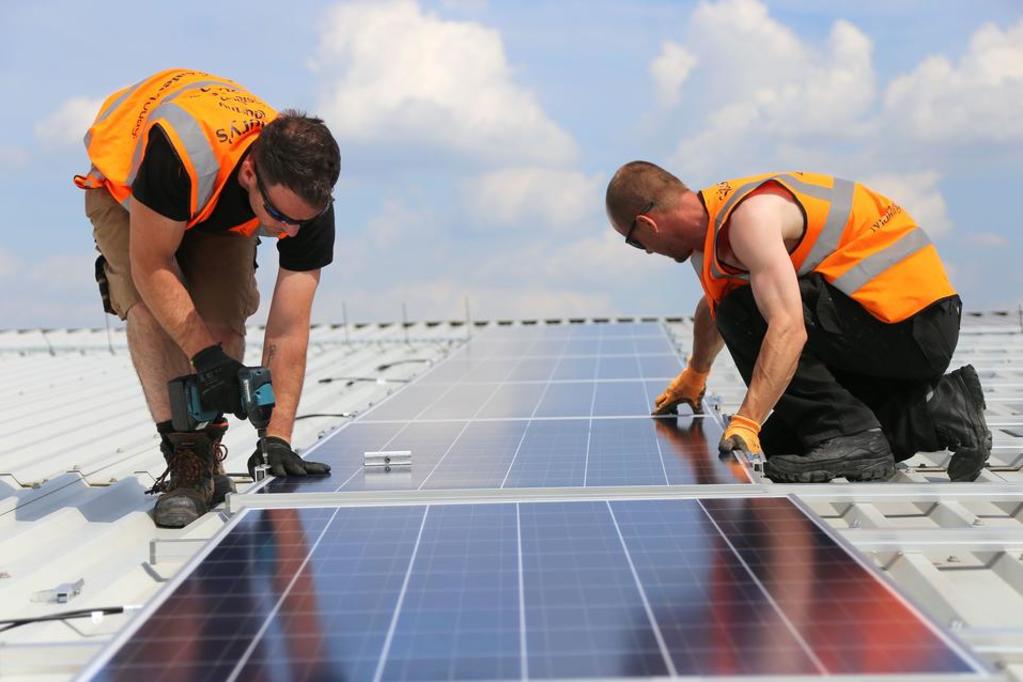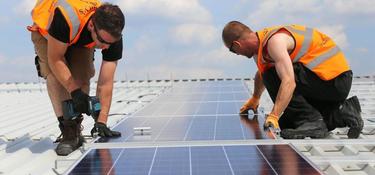
Ahead of UK’s targets to reach net zero by 2050, an increasing number of businesses are aligning their operations with their sustainability goals. As the leading owner, developer and investor of logistics property, we are committed to supporting our customers across all their business needs, especially when it comes to sustainability. One of the main ways we are doing that is through Prologis Essentials Energy solutions.
Comprised of four pillars – Operations, Energy and Sustainability, Mobility, and Workforce – Prologis Essentials is our way of supporting the bespoke requirements of every customer, providing tailored solutions to meet their operational needs.
Under the ‘Energy’ pillar, solar solutions are helping our customers reduce the carbon footprint created by their dependence on the grid. Designed to meet the customer’s energy usage, our on-site rooftop solar PV solution is proving to be one of the most popular ways of reducing operational costs due to its advantages:
- Solar energy is abundantly available and can be harnessed easily through proven PV technology, making it easily accessible to commerce and industry (C&I) consumers.
- The output capabilities of rooftop solar plants can range from kilowatts (kWp) to mega-watts (MWp), allowing customers to right-size their array based on their usage profile and available rooftop space.
- The cost of solar PV technology has rapidly reduced in the last decade, making solar power one of the cheapest sources of electricity. Grid electricity tariff rates have increased in the past few years, resulting in a reduced payback period for customers.
- Electricity generated from solar PV is cheaper than grid electricity, leading to potential savings on electricity bills.
- Solar plants are scalable; additional capacity can be added as customer’s energy requirements increase. Scalability is becoming increasingly important for customers that are trying to transition to electric fleets by 2030.
- The size of warehouses means that in many cases, an energy generation surplus can be achieved, allowing customers to export energy via the Smart Export Guarantee (SEG).
- On-site solar solutions are a clean and green energy generation source and produce minimal carbon emissions, reducing the environmental impact of electricity generation.
- Solar PV systems are static systems and therefore have low operations and maintenance costs compared to other power sources.
- Solar panels have a 20–25-year life span, making them a durable source of energy. Adopting solar energy emphasises a business’ commitment to sustainability and sense of responsibility towards communities and future generations.
Despite its many advantages, there are a number of considerations customers should be aware of when looking to integrate solar PV into their sustainability strategy.
It takes time and planning
Despite being highly accessible, customers should be aware of the time it takes to secure planning and Distribution Network Operator (DNO) approval, which can result in delays in implementation, especially for larger systems. From an initial enquiry to system installation, it can take around six to eight months.
We work closely with our customers throughout feasibility studies, support the planning process with local authority, secure grid connectivity approval from DNO and provide a turnkey solution, including design, engineering, procurement, installation and commissioning, making solar Essentials a hassle-free solution.
Another challenge is that DNO approvals determine limits on how much energy can be generated and exported back into the grid, based on the capacity of the local grid.
Balancing generation and storage
Solar PV projects generate energy during the daytime; the daily solar generation pattern follows a bell curve, while the energy consumption pattern of customer might be flat or uniform. This results in customers not getting full benefits of solar generation if their system is oversized. To avoid this, solar systems should be designed specifically to meet a customer’s energy consumption profile, reducing the size of solar array. Excess solar generation also leads to a drop in the demand of power from conventional sources of energy during peak hours. This creates a duck curve, which can result in grid stability issues.
An ideal solution for this is to have favourable on-site and grid scale battery storage policies and regulations, which would allow excess energy to be stored and used during non-generating hours. The storage-backed solar system will not only help stabilise the grid, but help customers maximise their on-site generation.
Our customer Kinaxia Logistics has been trialing the use of a battery storage solution in their 116,000 sq. ft. unit in Daventry. The system has allowed Kinaxia to be off-grid for over 40% of the time, demonstrating the value of having an integrated system.
Transitioning the grid and policy
The power grid in the UK is an ageing infrastructure, not designed to handle the vast volume of connections required for renewable schemes. This translates to the well documented issue with achieving grid connections, a problem which the Government and industry has committed to invest in and improve.
Widescale changes to energy policy are required to ensure renewable energy projects are viable. If favourable interactive policies are implemented, logistics operators will have the opportunity to generate vastly more energy than their own usage demands, supporting the wider energy transition towards net zero targets. Interactive grid policies, such as net metering, viable feed-in-tariff rates or community solar, could boost the implementation of distributed energy generation projects.
At Prologis UK, not only have all our buildings been solar PV ready for the past 15 years, but we have seen success implementing solar PV onto our Midland-based headquarters, installing a 75 kWp solar system. With our UK portfolio holding the potential to generate 266 MWp of energy per year, we turn our attention to projects across the country that could benefit from the surplus of energy our properties create, if changes to legislation allowed for it.
Balancing individual business requirements with national policy is no easy task, but as we edge closer to the goal of being net zero by 2050, big changes will be required to make sure sustainable efforts of businesses across the country are not wasted. Supply and demand must meet somewhere.
Karan Khatal, Sales Manager, Energy & Mobility Solutions, Prologis UK
